POWERPOINT PRESENTATION
Published on November 19, 2003
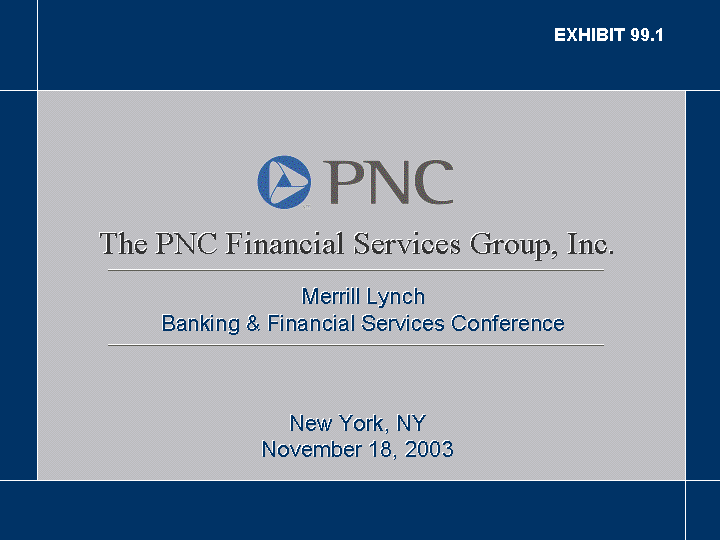
| The PNC Financial Services Group, Inc. New York, NY November 18, 2003 Merrill Lynch Banking & Financial Services Conference EXHIBIT 99.1 |

| Cautionary Statement Regarding Forward-Looking Information This presentation contains forward-looking statements with respect to PNC's outlook or expectations relating to its future business, operations, financial condition, financial performance and asset quality. Forward-looking statements are necessarily subject to numerous assumptions, risks and uncertainties. The forward-looking statements in this presentation are qualified by the factors affecting forward-looking statements identified in the more detailed Cautionary Statement included in PNC's written materials distributed at this conference and in the version of these slides posted on PNC's website at www.pnc.com as well as those factors previously disclosed in PNC's SEC reports (accessible on the SEC's website at www.sec.gov and on PNC's website). Future events or circumstances may change PNC's outlook or expectations and may also affect the nature of the assumptions, risks and uncertainties to which the forward-looking statements are subject. The forward-looking statements in this presentation speak only as of the date of this presentation, and PNC assumes no duty and does not undertake to update them. |
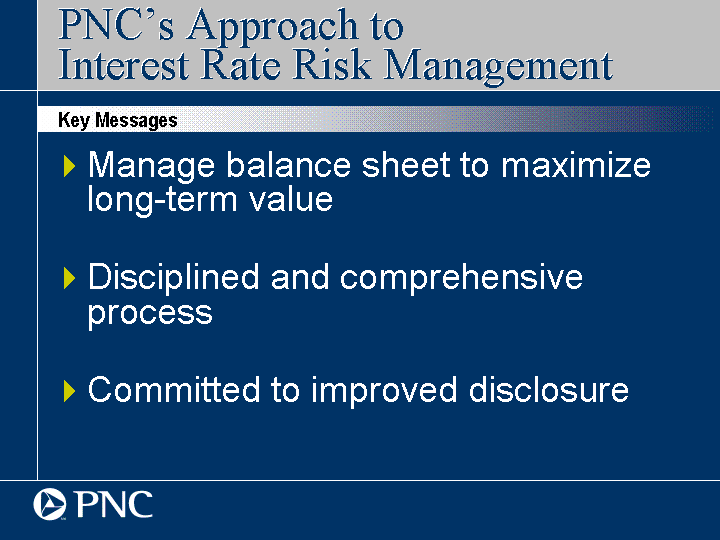
| PNC's Approach to Interest Rate Risk Management Manage balance sheet to maximize long-term value Disciplined and comprehensive process Committed to improved disclosure Key Messages |

| Issues Concerning Interest Rate Risk Management Is the value of the balance sheet exposed to rising or falling interest rates? What assumptions are made with respect to the lives and price behavior of the deposit base? What is the composition of the bond and swap portfolios? What types of mortgage-related assets are owned? Questions Investors Should Ask |
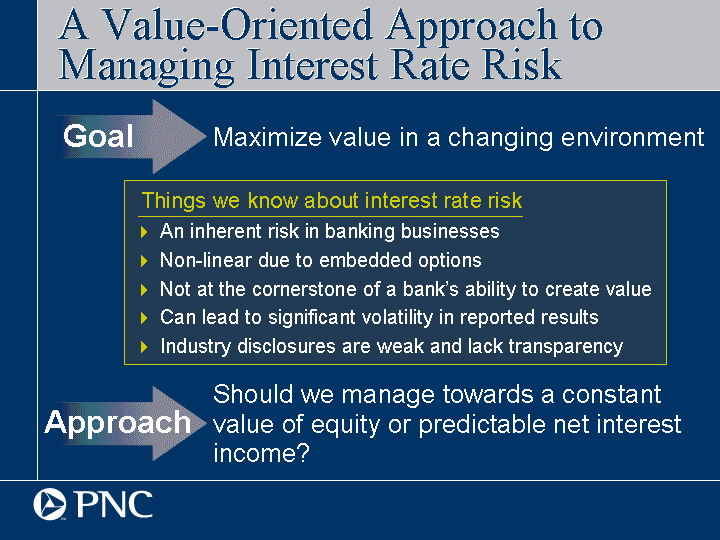
| A Value-Oriented Approach to Managing Interest Rate Risk Goal Maximize value in a changing environment Things we know about interest rate risk An inherent risk in banking businesses Non-linear due to embedded options Not at the cornerstone of a bank's ability to create value Can lead to significant volatility in reported results Industry disclosures are weak and lack transparency Approach Should we manage towards a constant value of equity or predictable net interest income? |

| Market View on Interest Rates Current Dec-03 Mar-04 Jun-04 Sep-04 Dec-04 Mar-05 Jun-05 Sep-05 Dec-05 Mar-06 Jun-06 Sep-06 Dec-06 Mar-07 Jun-07 Sep-07 Dec-07 Mar-08 Jun-08 Sep-08 Dec-08 30-Day Forward LIBOR 0.0112 0.0121 0.0129 0.0151 0.0194 0.023 0.0261 0.0292 0.0323 0.0348 0.0376 0.0403 0.0429 0.0431 0.0452 0.0472 0.0493 0.0491 0.0507 0.0522 0.0537 0.0525 3-Year Forward Swap 0.0275 0.0283 0.0309 0.0337 0.0364 0.0389 0.0411 0.0432 0.0452 0.0469 0.0484 0.0498 0.051 0.0521 0.0532 0.0541 0.0549 0.0557 0.0564 0.057 0.0576 0.0581 2003 2004 2005 2006 2007 2008 As of 11/14/03 30-Day Forward LIBOR 3-Year Forward Swap |

| Assets Commercial loans - fixed $5,000 $5,050 2.0 - Commercial loans - floating 10,000 10,000 0.1 100% Home equity installment loans 5,000 5,100 3.0 - Other consumer loans - fixed 5,000 5,050 2.5 - Total assets $25,000 $25,200 Liabilities and Equity Demand deposits $10,000 $8,800 3.8 - Money market 8,000 7,828 0.9 75% Time deposits - fixed 5,000 5,050 1.5 - Equity 2,000 3,522 - - Total liabilities and equity $25,000 $25,200 Book Value Sample Bank - Unhedged Balance Sheet Market Value $ millions Average Life (years) Rate Sensitivity Assumes unhedged balance sheet in a falling rate environment |

| Economic Value of Equity Interest Rate Changes Create Volatility in Value of Equity to the Sample Bank -100BPs -50 BPs Base +50 BPs +100BPs +200BPs Demand Deposits -308 -154 0 154 308 616 MMDA -73 -37 0 37 73 146 Time Deposits - Fixed -68 -34 0 34 68 136 Commercial Loans - Fixed 91 45 0 -45 -91 -182 Commercial Loans - Floating 8 4 0 -4 -8 -16 Home Equity Installment Loans 138 69 0 -69 -138 -275 Other Consumer - Fixed 114 57 0 -57 -114 -227 Economic Value of Equity -99 -50 0 50 99 198 Equity - Hedged $ millions Change in Value Assumes instantaneous parallel change in rates versus the forward yield curve |
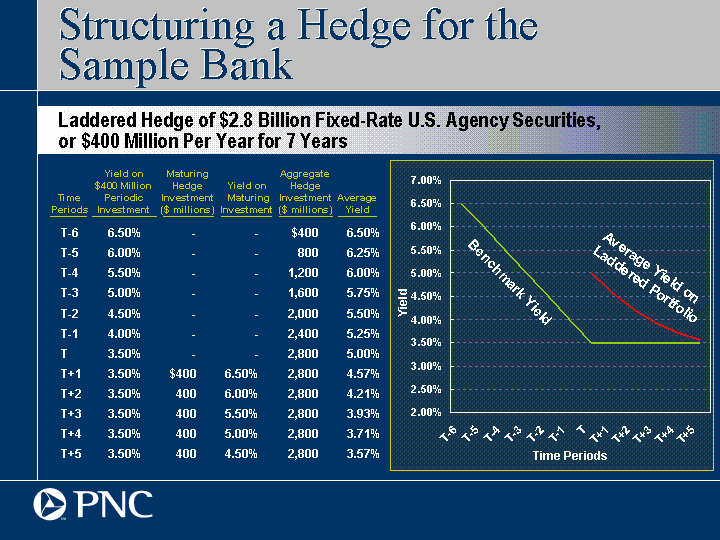
| Structuring a Hedge for the Sample Bank Laddered Hedge of $2.8 Billion Fixed-Rate U.S. Agency Securities, or $400 Million Per Year for 7 Years T-6 T-5 T-4 T-3 T-2 T-1 T T+1 T+2 T+3 T+4 T+5 Hedge Yield - Flat Rates 0.05 0.0457 0.0421 0.0393 0.0371 0.0357 Benchmark - Flat Rates 0.065 0.06 0.055 0.05 0.045 0.04 0.035 0.035 0.035 0.035 0.035 0.035 Yield Average Yield on Laddered Portfolio Benchmark Yield Time Periods T-6 6.50% - - $400 6.50% T-5 6.00% - - 800 6.25% T-4 5.50% - - 1,200 6.00% T-3 5.00% - - 1,600 5.75% T-2 4.50% - - 2,000 5.50% T-1 4.00% - - 2,400 5.25% T 3.50% - - 2,800 5.00% T+1 3.50% $400 6.50% 2,800 4.57% T+2 3.50% 400 6.00% 2,800 4.21% T+3 3.50% 400 5.50% 2,800 3.93% T+4 3.50% 400 5.00% 2,800 3.71% T+5 3.50% 400 4.50% 2,800 3.57% Time Periods Yield on $400 Million Periodic Investment Yield on Maturing Investment Aggregate Hedge Investment ($ millions) Average Yield Maturing Hedge Investment ($ millions) |

| Impact of Hedging Strategy Hedges Used to Maintain a Constant Value of Equity in the Sample Bank -100BPs -50 BPs Base +50 BPs +100BPs +200BPs $ millions Change in Value Laddered hedge: $2.8 billion of U.S. Agency securities Hedge Hedge Unhedged Equity Hedged Equity Assumes instantaneous parallel change in rates versus the forward yield curve |
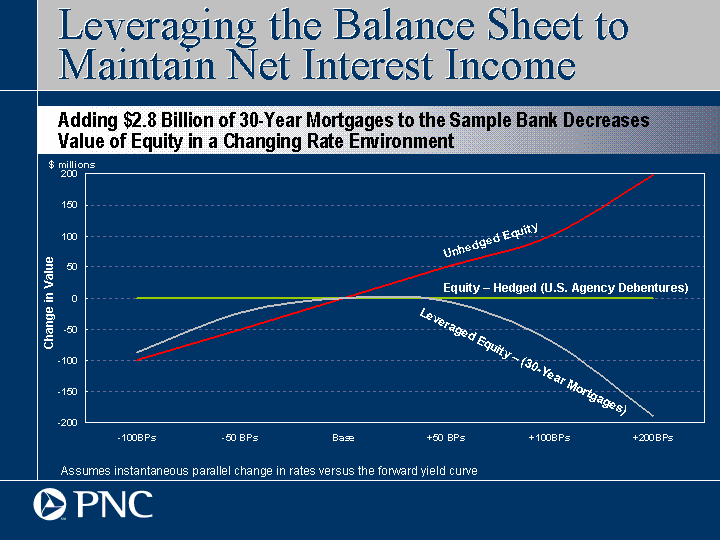
| Leveraging the Balance Sheet to Maintain Net Interest Income Adding $2.8 Billion of 30-Year Mortgages to the Sample Bank Decreases Value of Equity in a Changing Rate Environment -100BPs -50 BPs Base +50 BPs +100BPs +200BPs $ millions Change in Value Unhedged Equity Leveraged Equity - (30-Year Mortgages) Equity - Hedged (U.S. Agency Debentures) Assumes instantaneous parallel change in rates versus the forward yield curve |
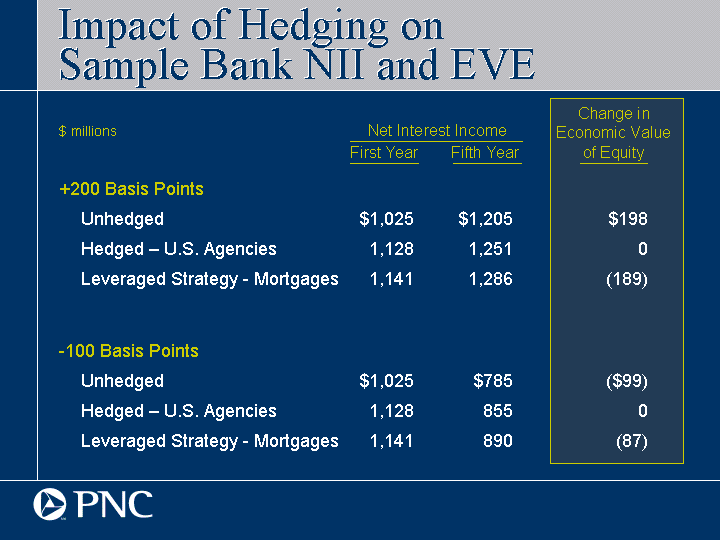
| Impact of Hedging on Sample Bank NII and EVE +200 Basis Points Unhedged $1,025 $1,205 $198 Hedged - U.S. Agencies 1,128 1,251 0 Leveraged Strategy - Mortgages 1,141 1,286 (189) -100 Basis Points Unhedged $1,025 $785 ($99) Hedged - U.S. Agencies 1,128 855 0 Leveraged Strategy - Mortgages 1,141 890 (87) First Year Fifth Year Net Interest Income $ millions Change in Economic Value of Equity |
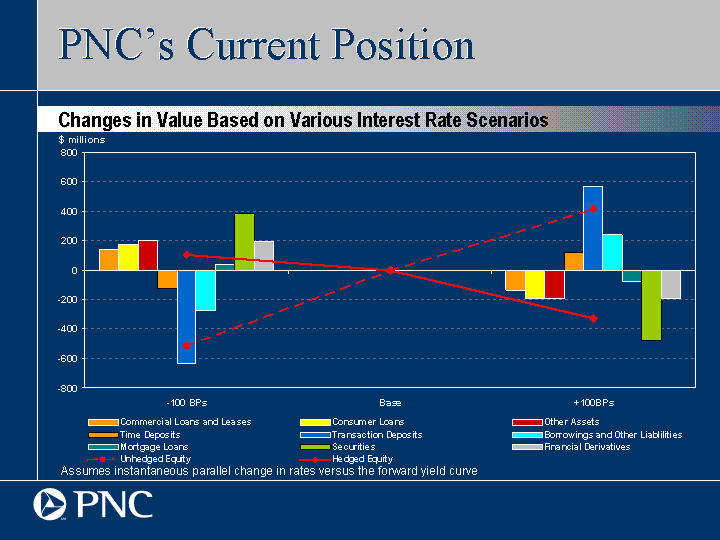
| PNC's Current Position Changes in Value Based on Various Interest Rate Scenarios -100 BPs Base +100BPs Commercial Loans and Leases 140.137 0 -132.315 Consumer Loans 173.072 0 -190.614 Other Assets 199.932 0 -196.289 Time Deposits -122.807 0 117.853 Transaction Deposits -633.812 0 571.825 Borrowings and Other Liablilities -271.317 0 243.134 Mortgage Loans 39.399 0 -75.517 Securities 385.074 0 -476.459 Financial Derivatives 194.609 0 -188.154 Unhedged Equity -514.795 0 413.594 Hedged Equity 104.287 0 -326.536 $ millions Assumes instantaneous parallel change in rates versus the forward yield curve |
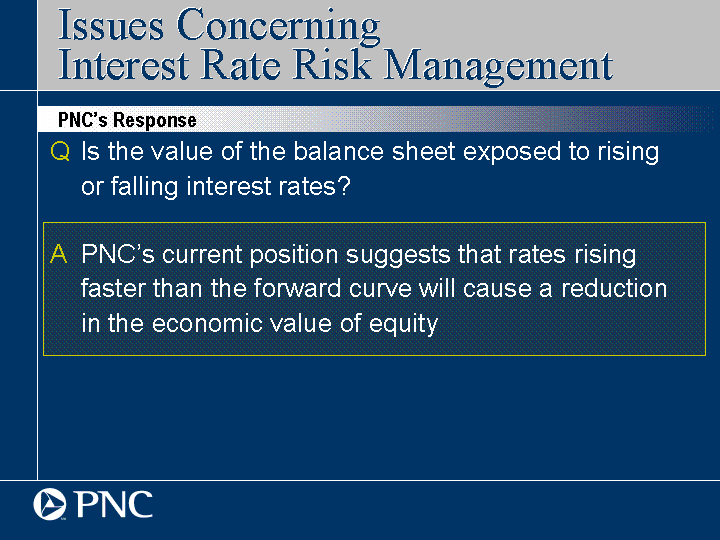
| Issues Concerning Interest Rate Risk Management Is the value of the balance sheet exposed to rising or falling interest rates? PNC's Response PNC's current position suggests that rates rising faster than the forward curve will cause a reduction in the economic value of equity |

| Issues Concerning Interest Rate Risk Management What is the composition of the bond and swap portfolios? PNC's Response U.S. Treasury and agency securities $1.9 2.2 Residential MBS 7.2 2.8 Commercial MBS 2.7 3.2 Asset-backed securities 2.5 2.1 All other 0.6 0.6 Total bonds $14.9 2.6 Receive fixed - loans $4.3 $0.1 2.1 Receive fixed - debt 2.3 0.3 3.6 Total swaps $6.6 $0.4 2.7 Fair Value Effective Duration +-50 BPs $ billions September 30, 2003 Notional Value |
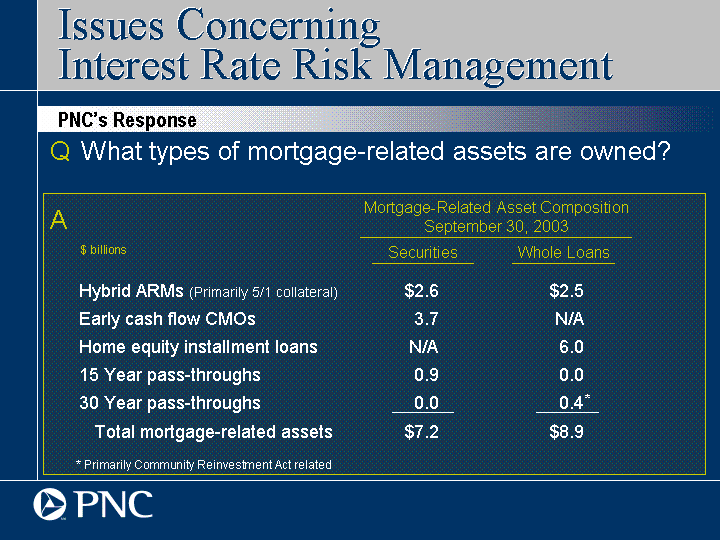
| Issues Concerning Interest Rate Risk Management What types of mortgage-related assets are owned? PNC's Response Mortgage-Related Asset Composition September 30, 2003 Hybrid ARMs (Primarily 5/1 collateral) $2.6 $2.5 Early cash flow CMOs 3.7 N/A Home equity installment loans N/A 6.0 15 Year pass-throughs 0.9 0.0 30 Year pass-throughs 0.0 0.4 Total mortgage-related assets $7.2 $8.9 $ billions Securities Whole Loans * * Primarily Community Reinvestment Act related |
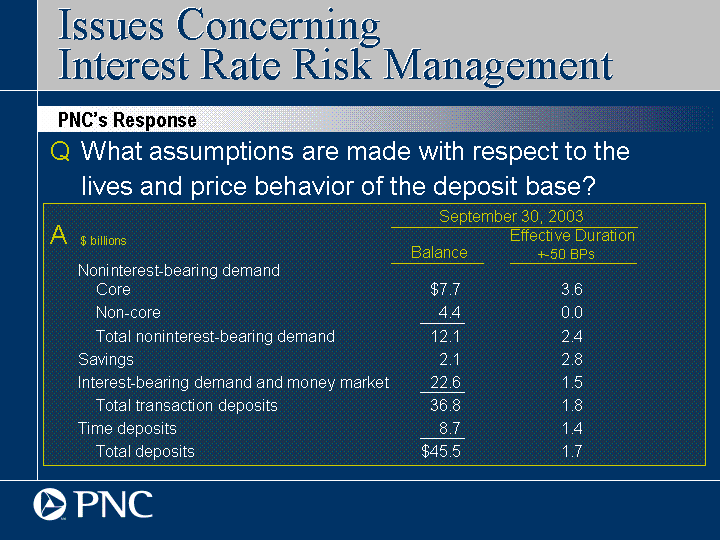
| Issues Concerning Interest Rate Risk Management What assumptions are made with respect to the lives and price behavior of the deposit base? PNC's Response Balance Noninterest-bearing demand Core $7.7 3.6 Non-core 4.4 0.0 Total noninterest-bearing demand 12.1 2.4 Savings 2.1 2.8 Interest-bearing demand and money market 22.6 1.5 Total transaction deposits 36.8 1.8 Time deposits 8.7 1.4 Total deposits $45.5 1.7 Effective Duration +-50 BPs $ billions September 30, 2003 |
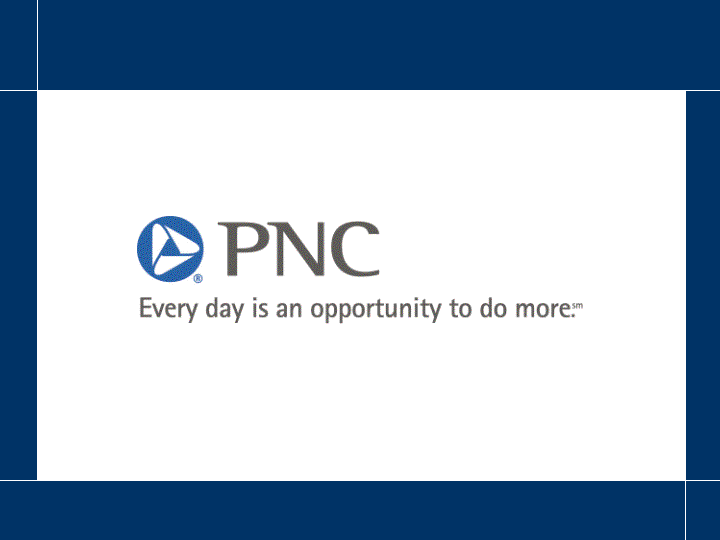
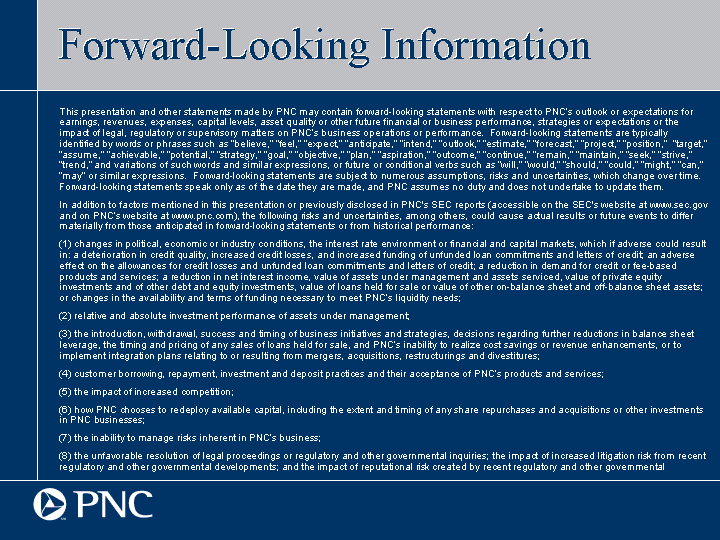
| Forward-Looking Information This presentation and other statements made by PNC may contain forward-looking statements with respect to PNC's outlook or expectations for earnings, revenues, expenses, capital levels, asset quality or other future financial or business performance, strategies or expectations or the impact of legal, regulatory or supervisory matters on PNC's business operations or performance. Forward-looking statements are typically identified by words or phrases such as "believe," "feel," "expect," "anticipate," "intend," "outlook," "estimate," "forecast," "project," "position," "target," "assume," "achievable," "potential," "strategy," "goal," "objective," "plan," "aspiration," "outcome," "continue," "remain," "maintain," "seek," "strive," "trend," and variations of such words and similar expressions, or future or conditional verbs such as "will," "would," "should," "could," "might," "can," "may" or similar expressions. Forward-looking statements are subject to numerous assumptions, risks and uncertainties, which change over time. Forward-looking statements speak only as of the date they are made, and PNC assumes no duty and does not undertake to update them. In addition to factors mentioned in this presentation or previously disclosed in PNC's SEC reports (accessible on the SEC's website at www.sec.gov and on PNC's website at www.pnc.com), the following risks and uncertainties, among others, could cause actual results or future events to differ materially from those anticipated in forward-looking statements or from historical performance: (1) changes in political, economic or industry conditions, the interest rate environment or financial and capital markets, which if adverse could result in: a deterioration in credit quality, increased credit losses, and increased funding of unfunded loan commitments and letters of credit; an adverse effect on the allowances for credit losses and unfunded loan commitments and letters of credit; a reduction in demand for credit or fee-based products and services; a reduction in net interest income, value of assets under management and assets serviced, value of private equity investments and of other debt and equity investments, value of loans held for sale or value of other on-balance sheet and off-balance sheet assets; or changes in the availability and terms of funding necessary to meet PNC's liquidity needs; (2) relative and absolute investment performance of assets under management; (3) the introduction, withdrawal, success and timing of business initiatives and strategies, decisions regarding further reductions in balance sheet leverage, the timing and pricing of any sales of loans held for sale, and PNC's inability to realize cost savings or revenue enhancements, or to implement integration plans relating to or resulting from mergers, acquisitions, restructurings and divestitures; (4) customer borrowing, repayment, investment and deposit practices and their acceptance of PNC's products and services; (5) the impact of increased competition; (6) how PNC chooses to redeploy available capital, including the extent and timing of any share repurchases and acquisitions or other investments in PNC businesses; (7) the inability to manage risks inherent in PNC's business; (8) the unfavorable resolution of legal proceedings or regulatory and other governmental inquiries; the impact of increased litigation risk from recent regulatory and other governmental developments; and the impact of reputational risk created by recent regulatory and other governmental |
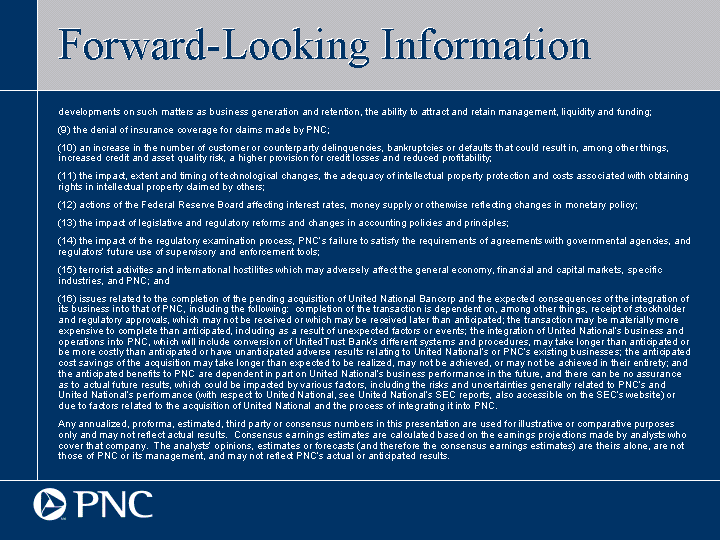
| Forward-Looking Information developments on such matters as business generation and retention, the ability to attract and retain management, liquidity and funding; (9) the denial of insurance coverage for claims made by PNC; (10) an increase in the number of customer or counterparty delinquencies, bankruptcies or defaults that could result in, among other things, increased credit and asset quality risk, a higher provision for credit losses and reduced profitability; (11) the impact, extent and timing of technological changes, the adequacy of intellectual property protection and costs associated with obtaining rights in intellectual property claimed by others; (12) actions of the Federal Reserve Board affecting interest rates, money supply or otherwise reflecting changes in monetary policy; (13) the impact of legislative and regulatory reforms and changes in accounting policies and principles; (14) the impact of the regulatory examination process, PNC's failure to satisfy the requirements of agreements with governmental agencies, and regulators' future use of supervisory and enforcement tools; (15) terrorist activities and international hostilities which may adversely affect the general economy, financial and capital markets, specific industries, and PNC; and (16) issues related to the completion of the pending acquisition of United National Bancorp and the expected consequences of the integration of its business into that of PNC, including the following: completion of the transaction is dependent on, among other things, receipt of stockholder and regulatory approvals, which may not be received or which may be received later than anticipated; the transaction may be materially more expensive to complete than anticipated, including as a result of unexpected factors or events; the integration of United National's business and operations into PNC, which will include conversion of UnitedTrust Bank's different systems and procedures, may take longer than anticipated or be more costly than anticipated or have unanticipated adverse results relating to United National's or PNC's existing businesses; the anticipated cost savings of the acquisition may take longer than expected to be realized, may not be achieved, or may not be achieved in their entirety; and the anticipated benefits to PNC are dependent in part on United National's business performance in the future, and there can be no assurance as to actual future results, which could be impacted by various factors, including the risks and uncertainties generally related to PNC's and United National's performance (with respect to United National, see United National's SEC reports, also accessible on the SEC's website) or due to factors related to the acquisition of United National and the process of integrating it into PNC. Any annualized, proforma, estimated, third party or consensus numbers in this presentation are used for illustrative or comparative purposes only and may not reflect actual results. Consensus earnings estimates are calculated based on the earnings projections made by analysts who cover that company. The analysts' opinions, estimates or forecasts (and therefore the consensus earnings estimates) are theirs alone, are not those of PNC or its management, and may not reflect PNC's actual or anticipated results. |
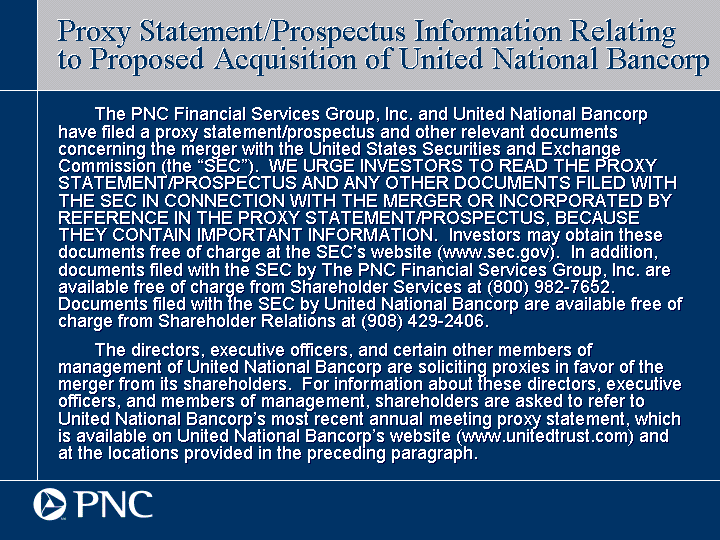
| Proxy Statement/Prospectus Information Relating to Proposed Acquisition of United National Bancorp The PNC Financial Services Group, Inc. and United National Bancorp have filed a proxy statement/prospectus and other relevant documents concerning the merger with the United States Securities and Exchange Commission (the "SEC"). WE URGE INVESTORS TO READ THE PROXY STATEMENT/PROSPECTUS AND ANY OTHER DOCUMENTS FILED WITH THE SEC IN CONNECTION WITH THE MERGER OR INCORPORATED BY REFERENCE IN THE PROXY STATEMENT/PROSPECTUS, BECAUSE THEY CONTAIN IMPORTANT INFORMATION. Investors may obtain these documents free of charge at the SEC's website (www.sec.gov). In addition, documents filed with the SEC by The PNC Financial Services Group, Inc. are available free of charge from Shareholder Services at (800) 982-7652. Documents filed with the SEC by United National Bancorp are available free of charge from Shareholder Relations at (908) 429-2406. The directors, executive officers, and certain other members of management of United National Bancorp are soliciting proxies in favor of the merger from its shareholders. For information about these directors, executive officers, and members of management, shareholders are asked to refer to United National Bancorp's most recent annual meeting proxy statement, which is available on United National Bancorp's website (www.unitedtrust.com) and at the locations provided in the preceding paragraph. |